
Blossoming Carolina Pony Foot, a small bitter edible found under foot. Photo by Green Deane
Are they edible? That is often asked about a small lawn plant called Pony Foot, or Dichondra carolinensis. I think they are bitter and medicinal, others toss them into salads. But since they are bitter it is better to mix them with other greens — as one does chicory — rather than using them as the main ingredient. They spread by means of runners and they taste a lot better without the runners. The species is also used as a ground cover in shade. I’m not sure why the plants were called Dichrondra which means two hearts. Its leaves do alternate but they are more kidney-shaped than heart-shaped. They also have a slightly off-side funnel shape (a basal notch.) While usually dime-size I have seen them more than an inch across. Pony Foot is often found with two other edibles, Dollarweed, which has a stem attached to the middle of the leaf, and Gotu Kola which has a spade-shaped leaf but rounded teeth on the margin and the stem is hairier.
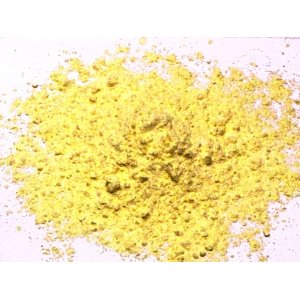
Sublimed sulfur to thwart tick attacks.
Before the state of Florida went on the Internet most of the information it thought fit for its citizens to know was produced in pamphlet form. When the shift was made to the Internet some information got lost or was dropped. One useful bit of advice was using sublimed sulfur to keep ticks off. Available online or through local pharmacies or chemical supply stores you put it in an old sock or the like and dust your cuffs and collar with it before entering tick habitat. It either repels them or vastly slows them down from finding a place to grab on, giving you more time to find the hardy ones. I have used it for many years very successfully. I still find a tick or two on me now and then but not attached. While I am not a biochemist I would suspect this would not be something you would do if you had a sulfur allergy.
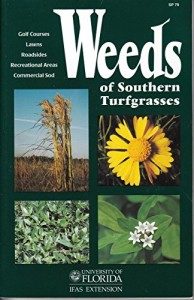
Weeds of Southern Turf Grasses
If you didn’t find a weed book you wanted under the Christmas tree here’s one you can pick up locally or order from the University of Florida: Weeds of Southern Turfgrasses. The book is not designed for foragers but rather land managers. However, the majority of the plants in the book are edible. It has 437 color photographs of 193 weed species found in the south usually on lawns and the like. As you can see by the link I have a list of the edible plants and what pages they are on. Many of my students just print the list then paste each entry on the appropriate page. There is also a link on the page to order it through the state of Florida. DO NOT ORDER IT THROUGH AMAZON OR OTHER BOOKSELLERS. Why? Because they can charge you from $49.95 to over $800 for a book you can buy at a local extension office for $8. If you order it through the link I provide it is $14 plus shipping. Yes, I actually found one bookseller asking over $800 for it. As it says on the link I do not get any money for recommending this book. It is just an inexpensive, handy book to have.
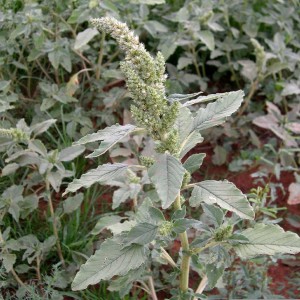
The Amaranth has a seed spike and often has a notch at the end of the leaf and a chevron-shaped watermark.
What is the prime mistake made by foragers? That’s very easy to answer: They make the plant fit the description. It happens to beginners and old hands as well. The beginners don’t see the details and the more experienced are irritated the plant doesn’t fit so they stretch the definitions. But as the bromide warns the devil is in the details. I will readily admit I loathe details. It is not me by nurture or nature. It is one of two reasons I did not stay with law…details and the you-must-win mentality even when you’re wrong. But details, as much as we might not like them, are what foraging is all about. If I can suppress my irritation with details and work with them so can you. The good part is that you can get to know a plant well enough that the details make a whole picture and you don’t have to think about them as much with plants you know.
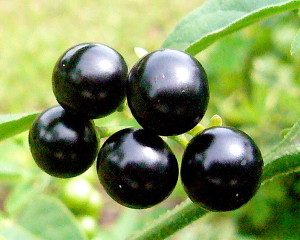
The Black Nightshade has berries. Photo by Green Deane
I had a friend who thought of himself as an outdoorsman thus beyond needing to study edible plants. He called me one day asking “how do I get the seeds out of the pigweed berries.” I knew there was a problem immediately. Our local “pigweed” does not have berries but our local nightshade does. Our “pigweed” (upper left photo) is an Amaranth and has seed spikes. About the size of fingers or more they are covered with tiny flowers that produce a multitude eye-of-the needle seeds, tan to black. No berries involved at all. Conversely the nightshade produces an umbrella-like spread of black shiny berries on one small stalk (photo to right.) It does have a lot of seeds inside the berries. So I thought I had better ask him why he wanted the seeds before I told him him the Amaranth didn’t have berries but the nightshade did. He wanted to grow some in his yard. They had been steaming the leaves and eating them like spinach! When I got done explaining he said “then that’s why we’ve all been getting headaches after eating the leaves.” Indeed. The leaves of this particular nightshade are edible but they must be boiled in one or two changes of water, not steamed.My friend had skipped many details. The wrong identification also led to the wrong preparation compounding the error. Admittedly they did have a few things in common. They were both green, grew at the same time and had leaves that can vaguely be the same rough diamond shape. But the difference between a seed spike of small green flowers vs. a cluster of shiny black berries is not paying attention to details. Fortunately no great harm was done.
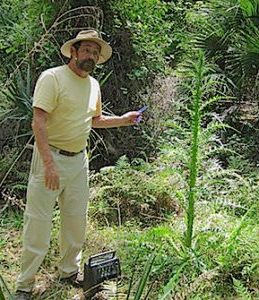
Foraging classes are held rain, shine or cold. Photo by Nermina Krenata
Foraging Classes: Last Saturday’s foraging class at Eagle Lake in Largo went well. It was a sight unseen but had plenty of wild edibles to identify. If you know of more place for such a class please let me know. Generally speaking state parks and or wilderness are not good locations. Large, old, city and county parks often are. They have a variety of different landscapes such as lawn, fields, woods, ponds et cetera.
Saturday, January 6th, Blanchard Park, 10501 Jay Blanchard Trail. Orlando, FL., 32817. 9 a.m. We meet next to the WMCA building at the tennis courts. It will be chilly, dress warmly.
Sunday, January 7th, Dreher Park, 1200 Southern Blvd., West Palm Beach, 33405, 9 a.m. We meet just north of the science center parking lot.
Sunday, January 14th, Florida State College, south campus, 11901 Beach Blvd., Jacksonville, 32246. 9 a.m. Meet in front of Building D.
Saturday, January 20th, Spruce Creek Park, 6250 Ridgewood Ave. Port Orange, 32127. 9 a.m., at the pavilion. (First right after entrance.)
Sunday, January 21st, Bayshore Live Oak Park, Bayshore Drive, Port Charlotte. 9 a.m. Meet at the parking lot at the intersection of Bayshore Road and Ganyard Street.
Sunday, March 4th, Eagle Park Lake, 1800 Keene Road, Largo, FL 33771. 9 a.m. Meet at the pavilion by the dog park.
To read more about the classes go here.

Poison Sumac only grow in wet spots. Photo by Green Deane
There’s a wide variety of Sumacs. Locally the local edible is the “Wing Sumac.” In other areas of the country it can be the Staghorn Sumac. Shapes and quality vary but they always have terminal clusters of garnet-colored berries, give or take a hue. The berries have hair on them. And on the hair is malic acid, the acid that makes apples tart. You can rinse off the acid and make a vitamin-C rich “lemonade.” The berries can then be dried, ground, and used as a spice. And in the springs the shoots can be peeled and eaten raw or cooked. If you are worried about Poison Sumac, to the right, it grows only in wet spots, has a much different leaf, and when in fruit has white berries positioned farther down the stem, not terminal clusters. Also Poison Sumac leaves have bright red stems.

Green Deane DVD Set
All of Green Deane’s videos available for free on You Tube. They do have ads on them so every time you watch a Green Deane video I get a quarter of one cent. Four views, one cent. Not exactly a large money-maker but it helps pays for this newsletter. If you want to see the videos without ads and some in slightly better quality you can order the DVD set. It is nine DVDs with 15 videos on each for a total of 135 videos. Many people want their own copy of the videos or they have a slow service and its easier to order then to watch them on-line. The DVDs make a good gift for that forager you know especially on long, cold winter months. Individual DVDs can also be ordered or you can pick and choose. You can order them by clicking on the button on the top right hand side of this page (if your window is open wide enough.) Or you can go here.

Keynote Speakers at the Florida Herbal Conference Linda and Luke Black Elk.
It’s time to be thinking about two conferences in February, Earthskills in Hawthorn, and the Florida Herbal Conference near Lake Wales. I lead plant walks at both events. Earthskills is Feb 7-11 and the Florida Herbal Conference is Feb 23-25. Both are now accepting registration. You can register at Earthskills here. Because you read this newsletter you can get a discount for the Florida Herbal Conference. If you register for that conference between now and January 31 using the code FHC2018_GREENDEANE you can get a 30% discount. Keynote speakers this year at the Florida Herbal Conference are Linda and Luke Black Elk from the Standing Rock Reservation. Linda (of the Catawba Nation) is an ethnobotanist specializing in teaching about culturally important plants and their uses as food and medicine. She is a lecturer at Sitting Bull College in Fort Yates, North Dakota. Luke Black Elk (Thít?u?wa? Lakota) is a storyteller, grassroots activist, and traditional spiritualist. He has conducted research in water restoration, sustainable building design, and food sovereignty, and hopes to use these techniques to encourage a more traditional way of life among his people. Luke has lived on the Cheyenne River Sioux Reservation his entire life, becoming deeply involved in cultural and community activities. For more information about the Florida Herbal Conference go here.

Green Deane Forum
Want to identify a plant? Looking for a foraging reference? Do you have a UFO, an Unidentified Flowering Object you want identified? On the Green Deane Forum we chat about foraging all year. And it’s not just about warm-weather plants or just North American flora. Many nations around the world share common weeds so there’s a lot to talk about. There’s also more than weeds. The reference section has information for foraging around the world. There are also articles on food preservation, and forgotten skills from making bows to fermenting food. One special section is “From the Frightening Mail Bag” where we learn from people who eat first then ask questions later. You can join the forum by clicking on “forum” in the menu.

Pokeweed seeds before soaking in battery acid. Photo by Green Deane
Weed Seeds: You can plant many weed seeds to get a crop of edible weeds closer to home, if not in your own yard (now you know why my putting-green neighbors loathe me.) Weeds are designed to take care of themselves and do quite well even when ignored. I have planted wild radish, peppergrass, chickeweed, purslane and crowsfoot grass on my “lawn” and they have done quite well. Many weeds can be planted in your garden. Chinopodiums and amaranth are two that need very little encouraging. Make them a row, barely cover the seeds with soil and you will have a mess o’ greens. Mustards are a bit pickier to grow. Their seeds, such as peppergrass, should be stored in a dry area for about four months between 50 and 68 degrees F for optimum germination. A cellar stairs is just about perfect for that, or outdoors in a Florida winter. Other seeds need special treatment.Pokeweed seeds are a good example. Their germination rate is very low, around 6 percent, if not treated. What’s treated? Replicating a bird’s gut. Soaking the seeds in battery acid for five minutes increases the germination rate into the 90s. You can buy the battery acid at auto stores. One container will last you decades. Once treated, plant successive rows of pokeweed seeds and have a lot of pokeweed from your garden. You can harvest the shoots or let them turn into big roots that will send up shoots annually.
This is weekly issue 285.
If you would like to donate to Eat The Weeds please click here.


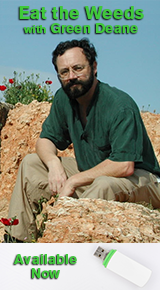
Good to hear from yo again! I have had Weeds of Southern Turfgrasses for many years. I have annotated it regarding edibilities, uses, etc. There are no weeds, just misplaced plants.